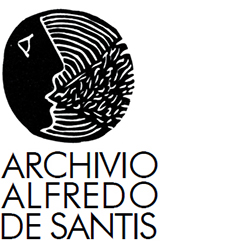Recognition of the work of the graphic painter Alfredo De Santis (1941-1998)
Leading representative of the Roman school of graphics, Alfredo De Santis (1941-1998) defined a completely personal graphic language, characterized by a continuous mix with cinema, painting, drawing, creating graphics with a strong pictorial value. Despite the importance of his contribution, the sudden and untimely death and the structural lack of attention to the history of graphics have helped to hide the traces of an atypical figure, for whom artistic research and communicative practice have constituted a single indissoluble path. In his own words, everything he created belonged to "a matrix of ideas, symbols, emotions, even in the case of strictly professional work". The presence of a rich private archive, kept in Rome at home by his wife Carla Conversi, who has always also been a workmate, and today a precious and essential witness of his work, allows us to give the right tribute to a great interpreter of the visual communication of the twentieth century. In addition to commissioned works, partially summarized by De Santis himself in the monograph Alfredo De Santis The path of a Sign (1986) until the mid-1980s, through the archive it is possible to reconstruct his entire creative-design process. In fact, envelopes with sketches and notes are preserved of the works carried out, but also a number of notebooks that show the brainstorming of a designer who essentially relied on the expressive freedom of the sign, able over time to encode recurring elements - - the wheel, the tree, the man, the eye, the hand, the Italian peninsula - capable of expressing issues that have never been overcome - racism, the mafia, the environment ... - topics on which he intervened and which he brought as a topic for discussion and planning in teaching at the IED in Rome. This attention to the social impact of creative work is also found in some pictorial cycles that tell crucial moments of contemporaneity: such as the pictorial series Signs on the wall, from 1990 in response to the fall of the Berlin Wall, Surgery in 1991 for the Gulf War, as well as the graphic projects on Eastern Europe and Sarajevo, conducted with Gianfranco Torri. Each of De Santis’ notebooks contain a graphic dissertation on topical issues, such as the study of the image for the political elections in Italy in April 1992, which then gave rise to a black and white lyrical story on the end of the First Republic ( see attached images). Born in August 1941, he began drawing very early thanks to the availability of paper, even in wartime, given by his father's profession, architect of the state. After studying at the Academy of Art in Rome with Turcato, Consagra and Mafai, a stay in Milan in the studio of Folco Lucarini is essential, where he comes into contact with the forge of Italian graphics, in Milan, the capital of publishing and industry in expansion. In 1964 the young man decided to return to Rome and bring the laws and requirements of a new graphic language into the purely artistic environment of the capital. The Ferro di Cavallo bookshop in Rome (like Milano Libri, in Milan) is the meeting place for young artists and intellectuals who, even before painting, shared a great love for cinema, from the neorealism with which they grew up to Antonioni's cinema. Between the end of the sixties and the early seventies Alfredo De Santis realizes some editorial projects for children: Alfazoo published in 1968 by the Emme editions of Rosellina Archinto, and game-books for Bompiani (I play you play we play and Just a sheet of paper, 1971-72). Since 1971, he has had numerous graphic themes for the RAI film cycles: Cinema 60s, La Commedia all'Italiana, Teleconfronto (1983-86), The Silent Film Days. After all, the wide cinematographic culture and the inclination for the moving image determine the figure of his graphic language. In 1982 he draws the identifying image of the "Days of silent cinema" festival in Pordenone and in 1985 it is the image of a research project on Italian comedy, as well as the logo and many posters for the Poor Theatre of Monticchiello. Cinema is certainly the main muse of De Santis, father of a graphic image in motion as well as of a design method that develops in a tight sequence of images (like the frame of a film) where creative intuition finds its unfolding until the final image, an aspect detailed in his Storyboard book. Animation graphics. Signs, sequences, stories (La Nuova Italia Scientific, 1989), conceived among other things as an educational basis for his courses at the IED in Rome. The other essential aspect of his graphics is the definition of the visual communication of newspapers and the propaganda of the PCI from 1973 to '77. In 1979 he redesigned the Genoese newspaper "Il Lavoro", in 1984 a subscription campaign for "La Repubblica" and from 85 the illustrations "il Manifesto" and the redesign of "Rinascita". In addition to his contribution to politics, his graphic work was used in defining the coordinated image in the sports sector - for the women's world ski championship in Piancavallo in 1986 and for the European basketball championships in Rome in 1991 - and businesslike , for example. for Gabriele Centazzo's Valcucine. A professional and creative path to be reconstructed, also on the basis of critical literature and the publication of his works in the main graphic magazines, both Italian and international: "Novum", "Art Directors Club Milano "," Idea "(Japan)," Graphicus "," Modern Publicity "," Visual Design "," Advertising in Italy "," Graphis "," Linea Grafica "," Italian Illustrators "," Ottagono ", “Domus”, “Japan Publications Trading Co”.

